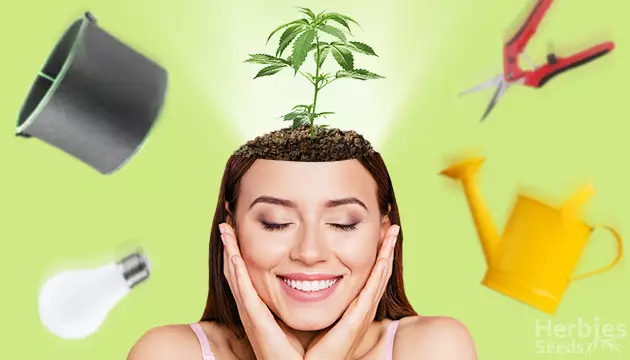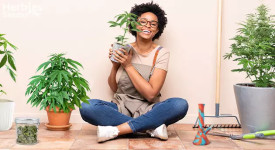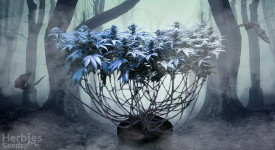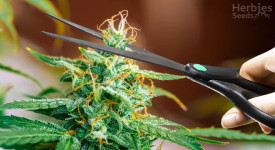People Answer: What Are Your Weed Growing Tips?

Despite its name, weed rarely grows and yields plentiful harvests on its own. Cannabis cultivation is a process that’s learned through experience and experimentation, trial and errors. Another great source of weed growing wisdom is, without a doubt, fellow growers. Today we’re asking our readers “What’s your secret to growing perfect weed?”. And here’s what they think.
George, 30, USA, a musician and professional grower
Environment is everything. I’ve seen so many growers who have some big problem going on in their garden and try everything to fix it to no avail. Often, there’s some environmental factor they’re overlooking.
For example, it’s important to taper down humidity throughout the flower cycle. Baby weed plants love high humidity. But if humidity stays high past the first 2 or 3 weeks of the flower phase, you’re asking for trouble. Pathogens like fungi love high humidity, as do bugs like fungus gnats and aphids.
One last thing that goes hand-in-hand with environment: don’t pack your plants in too close together! This was a big problem that I saw in many commercial cannabis gardens. The head grower wants to pump up his harvest numbers, so he packs as many plants as possible into his garden. Seems like a good idea, right?
Wrong. Packing in too many plants together prevents airflow and light penetration from getting beneath the canopy. Stale, stagnant air, low light, and plants touching one another is a recipe for bud or root rot. And since there are so many plants in a room, the infection spreads like wildfire and is impossible to stop. Don’t make that mistake!
Tanya, 36, UK/Spain, horsewoman
If you want to grow healthy, happy weed plants then my advice is to watch them closely and get to know them intimately. You should spend time with them every day, meticulously examining their leaves, stems and soil. Getting to know your plants is one of the best secrets for growing great weed. All plants are individuals and different strains have different growing needs.
Throughout the growing season, I love gazing adoringly at my weed plants. I enjoy watching them grow and getting lost in fantasies of big buds and a heavy harvest. As enjoyable as that is, it’s not the main reason I stare at my plants. When you take the time to look closely at your plants each day, you really get to know them and their growing needs.
Apart from the fact that the plants might actually enjoy your company and the extra co2 that you’re breathing on them, when you’re intimate with your plants, you can spot any changes right away. This could be yellowing, wilted, or curled leaves or evidence of pests. When you spot problems in the early stages, you have a better chance of helping your plant recover from them.
Around harvest time, my daily examination goes a bit deeper when I start probing my plants with a magnifying glass at least once a day. Getting to know your plant's trichomes is vital when it comes to harvesting them at the right time. By checking the trichomes daily, you can choose exactly what kind of high you want from your plants. Harvesting when the trichomes are still milky white will give you a more heady high. Or if you wait a bit longer for them to become amber/red then you'll have a more sedating smoke.
Adam, 32, a biologist from the US
I’m a biologist, not a botanist, so cannabis growing never came easy to me. However, after the first grow that went south very quickly, I realized that half of the success in cannabis cultivation comes from a well thought-over choice of seeds.
My first grow was a complete failure because I used bag seeds of an unknown strain. I was full of confidence, though, and planted them after reading just a couple of forums and getting a set of powerful HPS lights. Long story short, the cultivar turned out to be Sativa-dominant, and without proper training it has quickly overgrown the grow space, and started burning from the lights. Burning and growing, burning and growing in an endless cycle of my despair. (#1 tip on growing weed from me - don’t use HPS lights for small grow rooms, they’re way too hot! Go for LED lights for growing weed instead.)
After that I’ve learned a valuable lesson, and now can share one of the most obvious, but often overlooked marijuana growing tips - choose strains suitable for your experience and growing set up. If you’re a beginner, start with autoflowers. They are the quickest, the most compact, and by far the easiest type of cannabis seeds that you can choose. Then you can move to Indicas and Indica-dominant strains. They will be bigger, but here you can start experimenting with light training to control the height and shape of the plant. Your final destination, as I think, will be Sativas. They take the longest and can be quite demanding. I also only recommend growing them outdoors, so they could reach their full potential and develop into the huge trees that they are.
Lola, 22, UK, Marketing Consultant
This one’s high-risk high-reward, because you do run the risk of drying out your bud and losing it all. However, I have been experimenting with a tip I heard for extra resin: gradually decreasing the amount of water you give your plant in the last 3 weeks before harvest, when you should be flushing your plant as well to avoid chemical flavours. You have to be careful with this method though – I’ve learned the hard way! If you let the roots dry all the way out, that’s the harvest gone. However, you do want the roots to dry a bit – it causes your weed to smell stronger. Reducing the volume of water you use also ramps up resin production. I’m a seasoned smoker, so the more THC, the better!
Dinah, 21, Kenya, a student
A vital trait that an amateur weed grower should have is patience. Cannabis plants don't just come to be if they are not cared for and given enough time to mature well. These plants need a lot of attention.
- Grow your weed in optimal climatic conditions. The right temperature during the vegetative stage ranges from 70-85°F (20-30°C). In the flowering stage, temperatures should be at 65-80°F (18-26°C). Humid conditions are necessary for growth. Relative humidity during the vegetative growth should be 40-60% and 30-50% in the flowering stage. Anything less than 40% or more than 60% will slow plant growth. In the final weeks of flowering, humidity levels should be at 40-45%. During the vegetative period, ensure the plant gets 13-18 hours of light. In the flowering period, the plants should get 12 hours of light and 12 hours of darkness.
- Look into the type of strain you want to grow and see if it's favored by the climatic conditions available in that area you're growing it. Consider the amount of space available too. Sativas are bushier than Indicas hence require more space for growing.
- Use the correct procedure to dry the weed. Do not hurry the drying process. Don't remove the stem while drying. It is much easier to remove afterward. Hang the cannabis plants upside down so that they can dry thoroughly and leave them for 1 to 1 ½ weeks.
- Cure the buds. Put them in airtight jars for 2-3 weeks. After this period, you can open the jars and empty them, then refill them again with the same buds. The emptying of the jars prevents mold from growing.
Any Weed Growin’ Tips of your Own?
We know every grower has their own collection of cannabis growing tips. Sharing is caring, so why don’t you drop your own weed growing advice in the comments below?
Herbies Head Shop expressly refuses to support the use, production, or supply of illegal substances. For more details read our Legal Disclaimer.








Thank you for leaving a comment for us!
Your feedback will be posted shortly after our moderator checks it.
Please note that we don’t publish reviews that: